
Rüppell's bat, also known as Rüppell's pipistrelle, is a species of vesper bat found in Africa and Asian republics such as Iraq and Israel. It is the only member of the genus Vansonia. It is found in dry and moist savanna, subtropical or tropical dry shrubland, and hot deserts.
The rusty pipistrelle is a species of vesper bat. It is found in Angola, Botswana, Burkina Faso, Central African Republic, Chad, Ethiopia, Ghana, Kenya, Malawi, Mozambique, Namibia, Nigeria, Senegal, South Africa, Sudan, Tanzania, Uganda, Zambia, and Zimbabwe. Its natural habitats are dry and moist savanna. It is of note as perhaps Africa's smallest bat, at average weight of 3.5 g (0.12 oz).

The silvered bat is a species of vesper bat in the family Vespertilionidae. It is found in Angola, Burundi, Cameroon, Republic of the Congo, Democratic Republic of the Congo, Equatorial Guinea, Kenya, Malawi, Rwanda, and Tanzania. Its natural habitats are subtropical or tropical moist lowland forests and moist savanna.
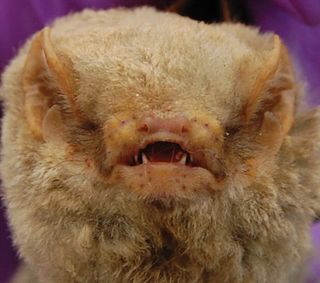
The Abo bat is a species of vesper bat in the family Vespertilionidae. It is found in several countries in West Africa and Central Africa. It is found in subtropical and tropical dry and moist lowland forests.

The variegated butterfly bat is a species of vesper bat. It is sometimes also called the leaf-winged bat, or simply the butterfly bat. It is not currently endangered, but may be threatened by habitat loss in some parts of its range.

Schlieffen's serotine, also known as Schlieffen's bat or Schlieffen's twilight bat, is a species of vesper bat found in Africa. It has been placed in numerous genera since its first description in 1859, but morphological and genetic studies have confirmed it as the only species in the genus Nycticeinops. It is named for the collector of the original specimen, Wilhelm von Schlieffen-Schlieffiennburg.
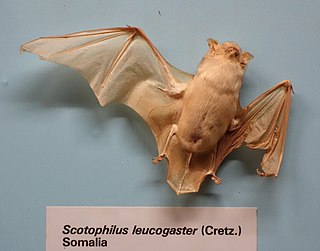
The white-bellied yellow bat or white-bellied house bat, is a species of vesper bat in the genus Scotophilus, the house bats. It can be found in Angola, Benin, Botswana, Burkina Faso, Cameroon, Central African Republic, Chad, Ivory Coast, Gambia, Ghana, Guinea, Guinea-Bissau, Kenya, Mali, Mauritania, Namibia, Niger, Nigeria, Senegal, Sierra Leone, Sudan, Togo, Uganda, and Zambia. It is found in dry and moist savanna and open woodland. It is a common species with a very wide range, and the International Union for Conservation of Nature has assessed its conservation status as being of "least concern".

The lesser woolly bat is a species of vesper bat in the family Vespertilionidae. It is found in Botswana, Central African Republic, Democratic Republic of the Congo, Ivory Coast, Ethiopia, Gabon, Ghana, Guinea, Kenya, Liberia, Malawi, Nigeria, South Africa, Tanzania, Zambia, Zimbabwe and rarely Ethiopia. Its natural habitats are subtropical or tropical moist lowland forests, dry savanna, and moist savanna. Members of this species typically have a dark greyish brown fur with whitish tips scattered throughout.

The Cape serotine is a species of vesper bat occurring in Sub-Saharan Africa. 'Serotine' is from Latin 'serotinus' meaning ‘of the evening'.
The Zulu serotine, also called the Zulu pipistrelle, aloe bat, or aloe serotine, is a species of vesper bat found in Angola, Botswana, Democratic Republic of the Congo, Ethiopia, Kenya, Malawi, Namibia, South Africa, South Sudan, Uganda, Zambia, and Zimbabwe. Its natural habitats are savanna and hot deserts.

Ansorge's free-tailed bat is a species of bat in the family Molossidae native to sub-Saharan Africa. It is named for W.J. Ansorge, who collected the first formally described specimen.
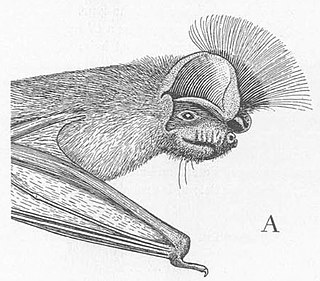
Chapin's free-tailed bat is a species of bat in the family Molossidae. It is found in central and southern Africa.

The little free-tailed bat is a species of the genus Mops in the family Molossidae. It is widely distributed across Africa and islands around the continent.

The Midas free-tailed bat is a species of bat scientifically classified in the order Chiroptera and the family Molossidae. It is distributed from western Africa to Saudi Arabia and further south. Its natural habitats are dry savanna, moist savanna, woodlands and hot deserts. The more southern are also known to live around large rivers or the swamps.

Darling's horseshoe bat is a species of bat in the family Rhinolophidae found in Africa. Its natural habitats are dry savanna, caves and other subterranean habitats.

Dent's horseshoe bat is a species of bat in the family Rhinolophidae. It is found in Angola, Botswana, Ghana, Guinea, Guinea-Bissau, Namibia, South Africa, and Zimbabwe. The bat's natural habitats are dry savannah country and it roosts in caves and other subterranean habitats.
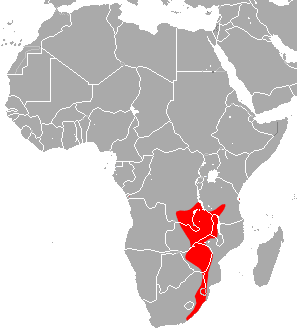
Swinny's horseshoe bat is a species of bat in the family Rhinolophidae. In English, R. swinnyi is commonly referred to as Swinny's horseshoe bat. In Afrikaans, it is commonly referred to as Swinny se saalneusvlermuis. This species belongs to the African clade. R. swinnyi was discovered by an African collector H. H. Swinny. They have been recorded in Angola, Republic of the Congo, Mozambique, South Africa, Tanzania, Zambia, Zimbabwe, and Malawi.
Roberts's flat-headed bat is a species of free-tailed bat native to southern Africa. It is the only species in the genus Sauromys. The scientific name translates as "rock loving lizard-mouse", while the common name honours Austin Roberts, who first described the species.

Kerivoula is a genus of vesper bats in the subfamily Kerivoulinae. They are found throughout tropical and subtropical regions of Africa, Asia, and New Guinea.
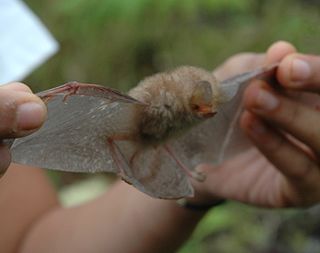
Kerivoulinae is a subfamily of vesper bats. There are 25 species in 2 genera within this subfamily:

















